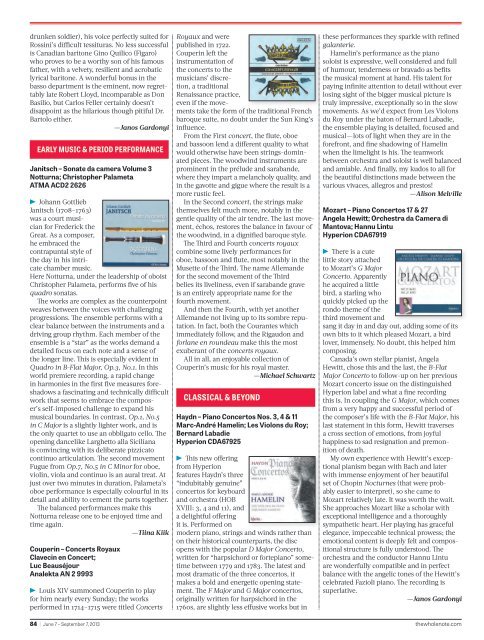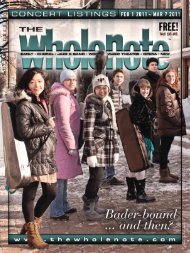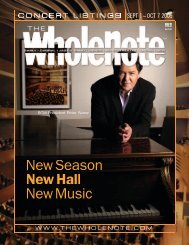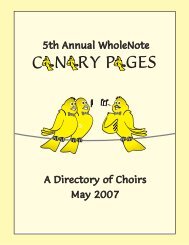You also want an ePaper? Increase the reach of your titles
YUMPU automatically turns print PDFs into web optimized ePapers that Google loves.
drunken soldier), his voice perfectly suited forRossini’s difficult tessituras. No less successfulis Canadian baritone Gino Quilico (Figaro)who proves to be a worthy son of his famousfather, with a velvety, resilient and acrobaticlyrical baritone. A wonderful bonus in thebasso department is the eminent, now regrettablylate Robert Lloyd, incomparable as DonBasilio, but Carlos Feller certainly doesn’tdisappoint as the hilarious though pitiful Dr.Bartolo either.—Janos GardonyiEARLY MUSIC & PERIOD PERFORMANCEJanitsch – Sonate da camera Volume 3Notturna; Christopher PalametaATMA ACD2 2626!!Johann GottliebJanitsch (1708–1763)was a court musicianfor Frederick theGreat. As a composer,he embraced thecontrapuntal style ofthe day in his intricatechamber music.Here Notturna, under the leadership of oboistChristopher Palameta, performs five of hisquadro sonatas.<strong>The</strong> works are complex as the counterpointweaves between the voices with challengingprogressions. <strong>The</strong> ensemble performs with aclear balance between the instruments and adriving group rhythm. Each member of theensemble is a “star” as the works demand adetailed focus on each note and a sense ofthe longer line. This is especially evident inQuadro in B-Flat Major, Op.3, No.1. In thisworld premiere recording, a rapid changein harmonies in the first five measures foreshadowsa fascinating and technically difficultwork that seems to embrace the composer’sself-imposed challenge to expand hismusical boundaries. In contrast, Op.1, No.5in C Major is a slightly lighter work, and isthe only quartet to use an obbligato cello. <strong>The</strong>opening dancelike Larghetto alla Sicilianais convincing with its deliberate pizzicatocontinuo articulation. <strong>The</strong> second movementFugue from Op.7, No.5 in C Minor for oboe,violin, viola and continuo is an aural treat. Atjust over two minutes in duration, Palameta’soboe performance is especially colourful in itsdetail and ability to cement the parts together.<strong>The</strong> balanced performances make thisNotturna release one to be enjoyed time andtime again.—Tiina KiikCouperin – Concerts RoyauxClavecin en Concert;Luc BeauséjourAnalekta AN 2 9993!!Louis XIV summoned Couperin to playfor him nearly every Sunday; the worksperformed in 1714–1715 were titled ConcertsRoyaux and werepublished in 1722.Couperin left theinstrumentation ofthe concerts to themusicians’ discretion,a traditionalRenaissance practice,even if the movementstake the form of the traditional Frenchbaroque suite, no doubt under the Sun King’sinfluence.From the First concert, the flute, oboeand bassoon lend a different quality to whatwould otherwise have been strings-dominatedpieces. <strong>The</strong> woodwind instruments areprominent in the prélude and sarabande,where they impart a melancholy quality, andin the gavotte and gigue where the result is amore rustic feel.In the Second concert, the strings makethemselves felt much more, notably in thegentle quality of the air tendre. <strong>The</strong> last movement,échos, restores the balance in favour ofthe woodwind, in a dignified baroque style.<strong>The</strong> Third and Fourth concerts royauxcombine some lively performances foroboe, bassoon and flute, most notably in theMusette of the Third. <strong>The</strong> name Allemandefor the second movement of the Thirdbelies its liveliness, even if sarabande graveis an entirely appropriate name for thefourth movement.And then the Fourth, with yet anotherAllemande not living up to its sombre reputation.In fact, both the Courantes whichimmediately follow, and the Rigaudon andforlane en roundeau make this the mostexuberant of the concerts royaux.All in all, an enjoyable collection ofCouperin’s music for his royal master.—Michael SchwartzCLASSICAL & BEYONDHaydn – Piano Concertos Nos. 3, 4 & 11Marc-André Hamelin; Les Violons du Roy;Bernard LabadieHyperion CDA67925!!This new offeringfrom Hyperionfeatures Haydn’s three“indubitably genuine”concertos for keyboardand orchestra (HOBXVIII: 3, 4 and 11), anda delightful offeringit is. Performed onmodern piano, strings and winds rather thanon their historical counterparts, the discopens with the popular D Major Concerto,written for “harpsichord or fortepiano” sometimebetween 1779 and 1783. <strong>The</strong> latest andmost dramatic of the three concertos, itmakes a bold and energetic opening statement.<strong>The</strong> F Major and G Major concertos,originally written for harpsichord in the1760s, are slightly less effusive works but inthese performances they sparkle with refinedgalanterie.Hamelin’s performance as the pianosoloist is expressive, well considered and fullof humour, tenderness or bravado as befitsthe musical moment at hand. His talent forpaying infinite attention to detail without everlosing sight of the bigger musical picture istruly impressive, exceptionally so in the slowmovements. As we’d expect from Les Violonsdu Roy under the baton of Bernard Labadie,the ensemble playing is detailed, focused andmusical — lots of light when they are in theforefront, and fine shadowing of Hamelinwhen the limelight is his. <strong>The</strong> teamworkbetween orchestra and soloist is well balancedand amiable. And finally, my kudos to all forthe beautiful distinctions made between thevarious vivaces, allegros and prestos!—Alison MelvilleMozart – Piano Concertos 17 & 27Angela Hewitt; Orchestra da Camera diMantova; Hannu LintuHyperion CDA67919! ! <strong>The</strong>re is a cutelittle story attachedto Mozart’s G MajorConcerto. Apparentlyhe acquired a littlebird, a starling whoquickly picked up therondo theme of thethird movement andsang it day in and day out, adding some of itsown bits to it which pleased Mozart, a birdlover, immensely. No doubt, this helped himcomposing.Canada’s own stellar pianist, AngelaHewitt, chose this and the last, the B-FlatMajor Concerto to follow-up on her previousMozart concerto issue on the distinguishedHyperion label and what a fine recordingthis is. In coupling the G Major, which comesfrom a very happy and successful period ofthe composer’s life with the B-Flat Major, hislast statement in this form, Hewitt traversesa cross section of emotions, from joyfulhappiness to sad resignation and premonitionof death.My own experience with Hewitt’s exceptionalpianism began with Bach and laterwith immense enjoyment of her beautifulset of Chopin Nocturnes (that were probablyeasier to interpret), so she came toMozart relatively late. It was worth the wait.She approaches Mozart like a scholar withexceptional intelligence and a thoroughlysympathetic heart. Her playing has gracefulelegance, impeccable technical prowess; theemotional content is deeply felt and compositionalstructure is fully understood. <strong>The</strong>orchestra and the conductor Hannu Lintuare wonderfully compatible and in perfectbalance with the angelic tones of the Hewitt’scelebrated Fazioli piano. <strong>The</strong> recording issuperlative.—Janos Gardonyi84 | June 7 – September 7, 2013 thewholenote.com
















